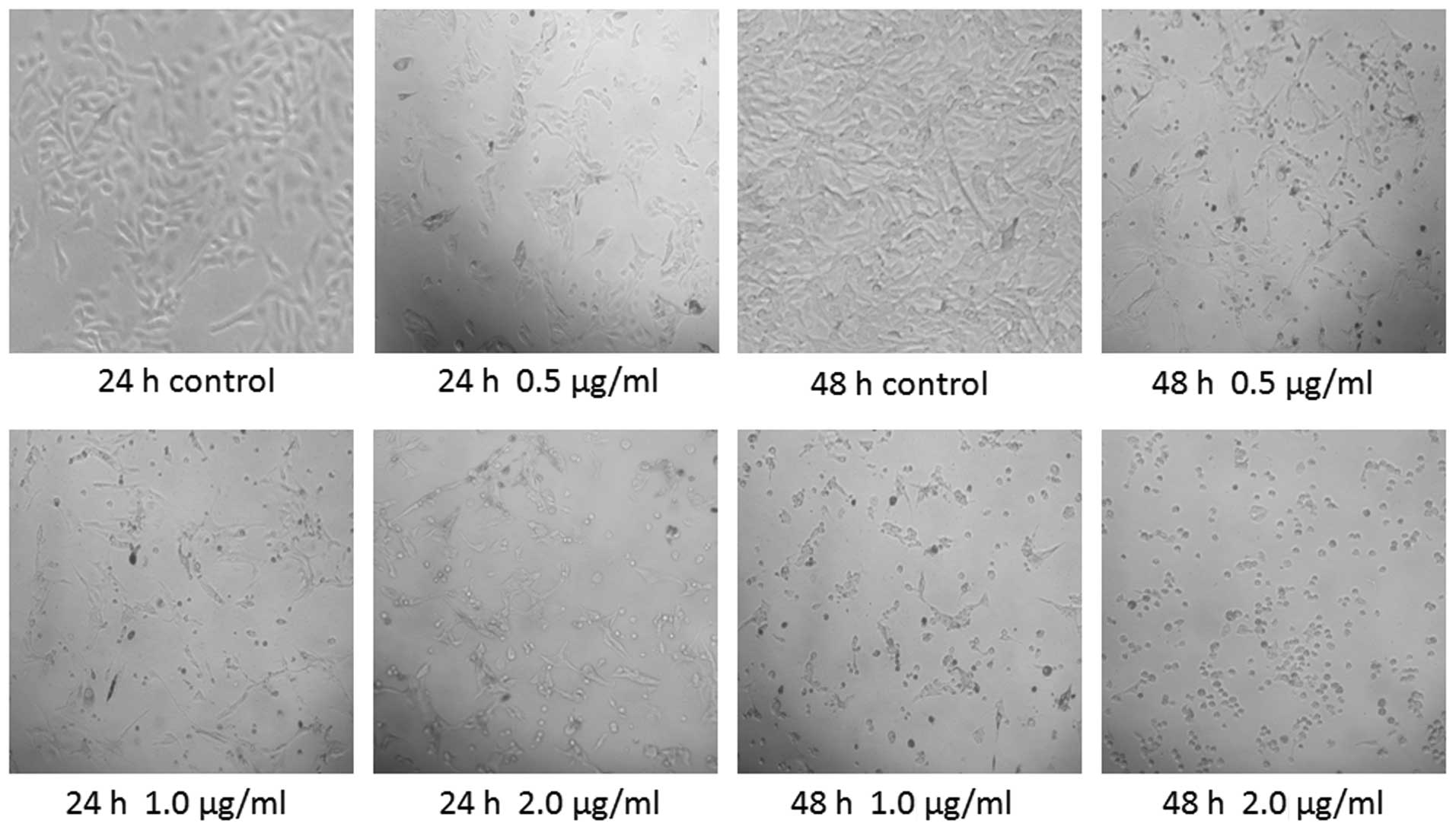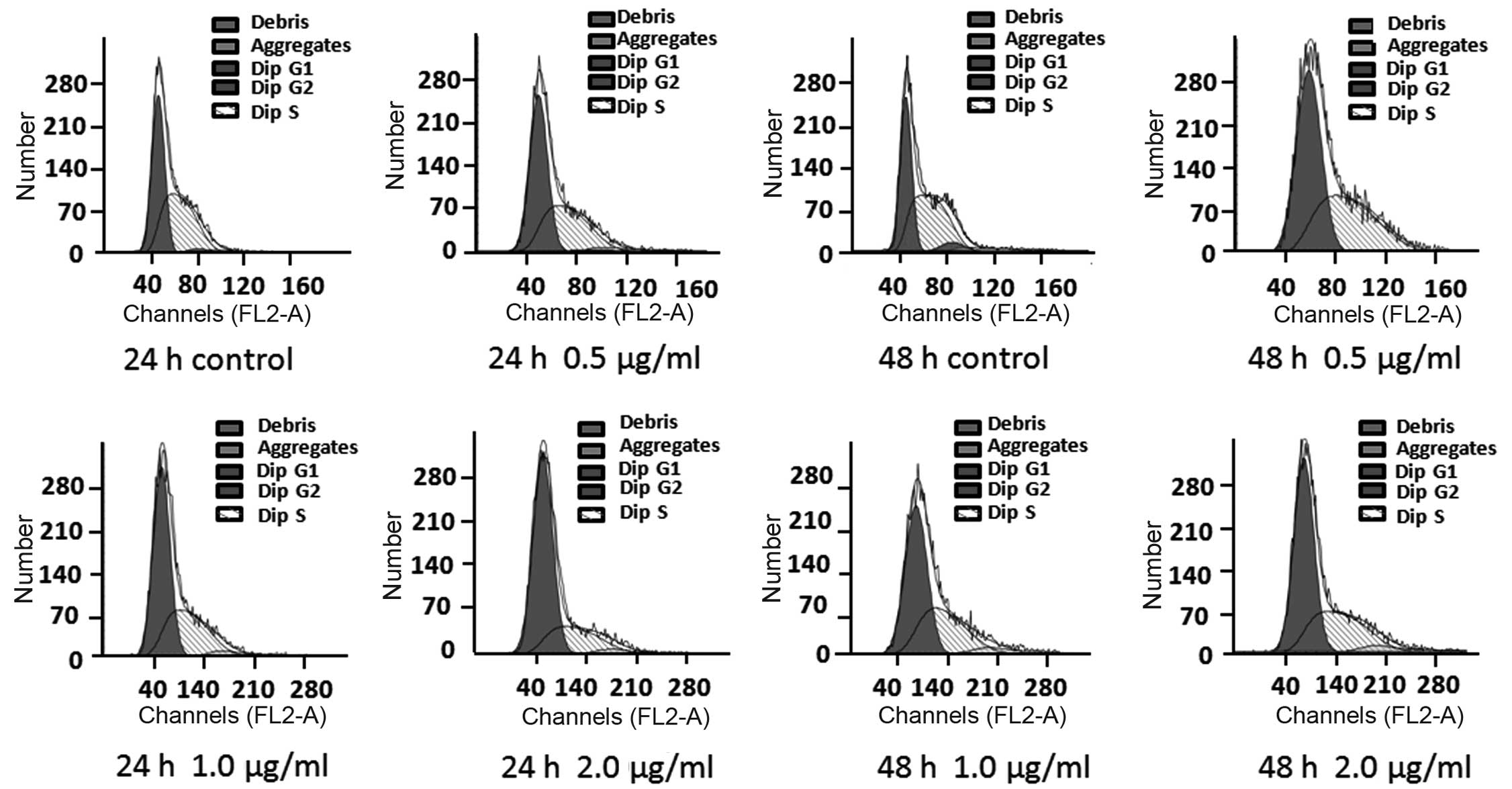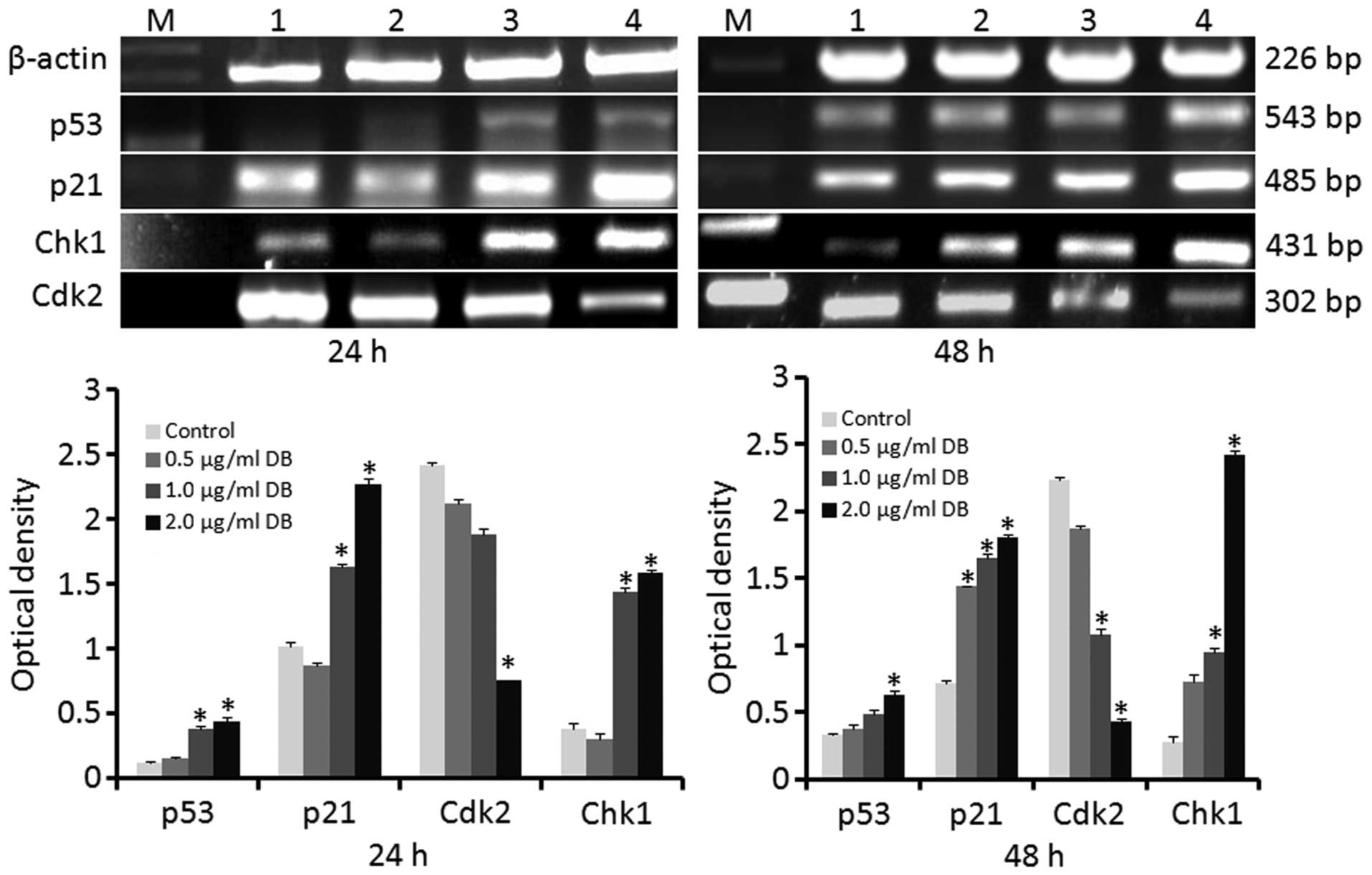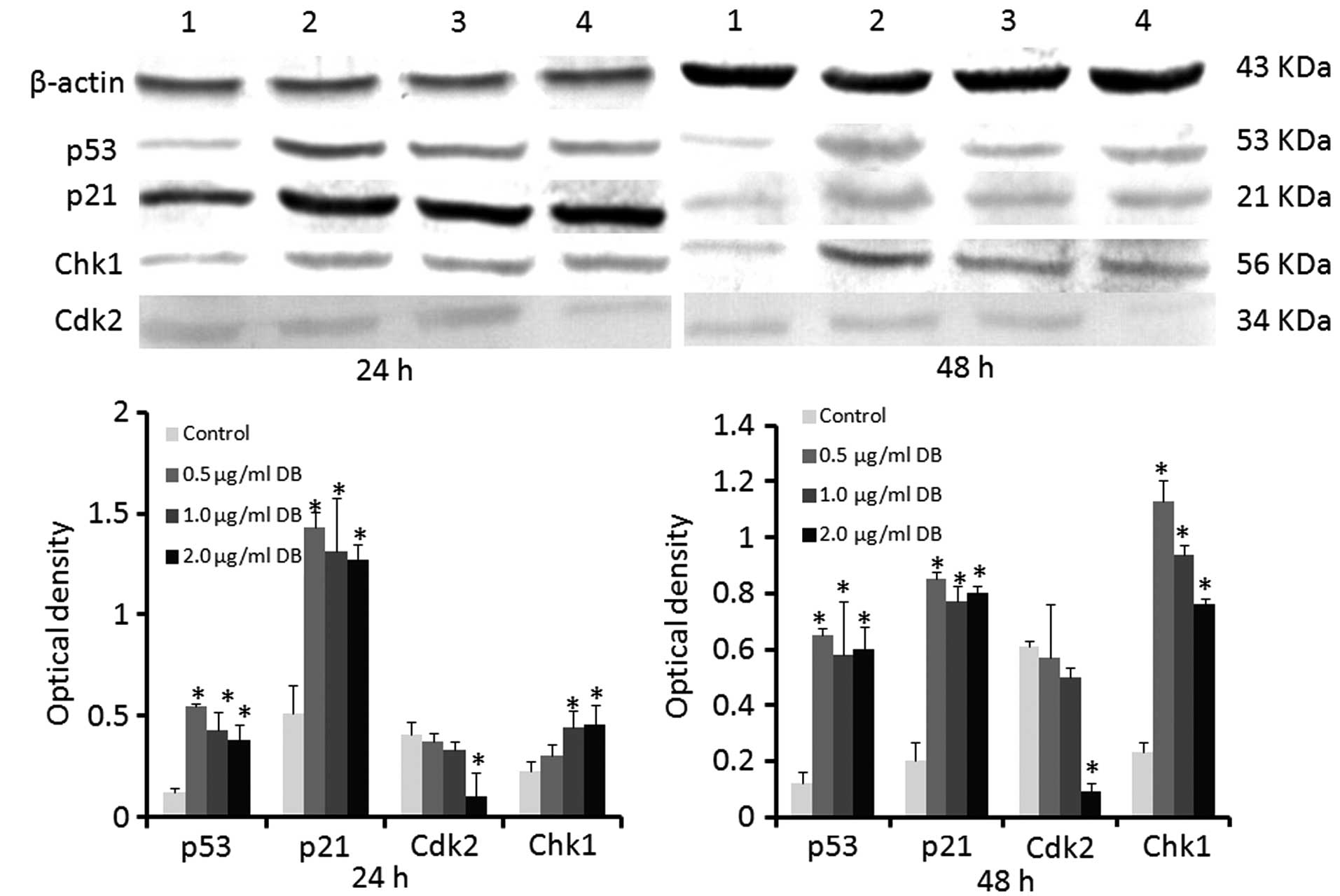Diterpenoid B derived from Plectranthus excisus inhibits the melanoma cell cycle in the B16 melanoma cell line
- Authors:
- Published online on: June 23, 2015 https://doi.org/10.3892/mmr.2015.3986
- Pages: 4578-4583
Abstract
Introduction
Plectranthus excisus and other tea-leaves of the Labiatae family are Isodons, which are widely distributed throughout northeast China. Diterpenoids, which are a typical component of Isodons, exhibit antitumor, antibacterial, anti-inflammatory and antioxidant effects, and provide cardiovascular protection (1–4). Diterpenoid B (DB) is synthesized by Plectranthus excisus. Previous studies have demonstrated that a number of Isodons contain extractable diterpenoids. In China, Isodon plants are currently used as raw materials to produce medicines, including tablet-based rubescens and anticancer drugs (5,6). This present study aimed to provide a theoretical basis for the development of caudate lobe Isodon plants, and investigate whether DB is able to inhibit the proliferation and progression of melanoma. This was with the aim to establish a theoretical basis for the anti-tumor effect of traditional Chinese medicine.
Materials and methods
Reagents
The DB used in the present study was obtained from China-Japan Union Hospital chemical laboratory and 3-(4,5-dimethylthiazol-2-yl)-2,5-diphenyltetrazolium bromide (MTT) was purchased from Sigma-Aldrich (St. Louis, MO, USA). RPMI-1640 medium was purchased from Gibco Life Technologies (Carlsbad, CA, USA) and fetal bovine serum was purchased from HyClone Corp. (Logan, UT, USA). The following antibodies were purchased from Santa Cruz Biotechnology, Inc. (Dallas, TX, USA): Rabbit polyclonal cyclin-dependent kinase 2 (Cdk2; sc-163; 1:200), mouse monoclonal transformation related protein 53 (p53; sc-126; 1:200), rabbit polyclonal cyclin-dependent kinase inhibitor 1A (p21; sc-397; 1:200) and rabbit polyclonal checkpoint kinase 1 (Chk1; sc-7898; 1:200). Goat anti-mouse (sc-2005) and anti-rabbit (sc-2054) immunoglobulin G horseradish peroxidase-conjugated secondary antibodies were used (1:1,000; Santa Cruz Biotechnology, Inc.). The anti-β-actin antibody was purchased from Promega Corporation (Madison, WI, USA).
Cell culture
The B16 mouse melanoma cell line was maintained in RPMI-1640 medium, containing 10% fetal bovine serum, in an incubator with 5% CO2 at 37°C. Trypsin (0.25%) was used to digest the cells.
MTT assay
B16 cells in the logarithmic growth phase were seeded into 96-well plates at ~5×104 cells/ml. Following incubation for 24 h at 37°C, the cells were exposed to 0.5, 1.0, 2.0, 4.0, 8.0, 16.0 and 32.0 µg/ml of DB (the experimental groups) or remained untreated (control), with four wells for each group. The cells were further divided into 24 and 48 h treatment groups. Every 24 h, MTT (20 µl of a 5 µg/ml solution) was added to the wells containing the cultured cells, which were then incubated for 4 h. Following incubation at 37°C, the culture medium was removed and 150 µl dimethyl sulfoxide was added. The absorbance (A) was measured using a microplate reader (Bio-Rad 550; Bio-Rad Laboratories, Inc., Hercules, CA, USA) at 490 nm, and the rate of the inhibition of cell growth was calculated using the following formula: Cell growth inhibition rate (%) = (1 − Aexperimental group / Acontrol group) × 100.
Analysis of cell morphology
B16 cells in the logarithmic growth phase were digested with trypsin and seeded into 96-well plates with 100 µl/well suspension containing ~5×104 cells/ml. Following culture for 24 h, the media was discarded. The doses of DB and the incubation durations were as described for the MTT assay above. The morphology of the cells was observed using an inverted phase contrast microscope (BX41-PHD-P11; Olympus, Numazu-shi, Japan).
Reverse transcription-quantitative polymerase chain reaction (RT-qPCR)
The mRNA expression was measured in the B16 cells in the logarithmic growth phase following treatment with DB (0.5, 1.0 and 2.0 µg/ml) for 24 or 48 h. The cells were digested with 0.25% trypsin and pelleted by centrifugation at 2,000 × g for 5 min at 37°C. The total RNA was extracted with TRIzol (Invitrogen Life Technologies, Carlsbad, CA, USA) and the concentration and purity of the RNA samples were determined by measuring the A260 and A280 optical density values using an ultraviolet (UV) spectrophotometer (UV-2401PC; Bayer AG, Leverkusen, Germany). The cDNA (100 ng) was obtained by RT of 1 µg mRNA with SMART® MMLV Reverse Transcriptase (639523; Takara Bio, Inc., Otsu, Japan). The PCR kit used was 2XEasyTaq PCR SuperMix (AS111-02; Beijing TransGen Biotech Co., Ltd., Beijing, China). The primer sequences, which were obtained from Sangon Biotech, Co., Ltd. (Shanghai, China), were as follows: p53, upstream 5′-CATGGACGATCTGTTGCTG-3′ and downstream 5′-TCGGGTGGCTCATAAGGT-3′; p21, upstream 5′-AGCTCAATGGACTGGAAGGG-3′ and downstream 5′-GAGCTGGAAGGTGTTTGGGG-3′; Cdk2, upstream 5′-GTTGACGGGAGAAGTTGTGG-3′ and downstream 5′-GAAGGACACGGTGAGAATGG-3′; Chk1, upstream 5′-CTTTGGGAGAAGGTGCCTAT-3′ and downstream 5′-ATGCCGAAATACCGTTGC-3′. β-actin was used as an internal control to assess the quality of the cDNA templates. The sequences of the β-actin primers were as follows: Upstream 5′-GTAAAGACCTCTATGCCAACACA-3′ and downstream 5′-GGACTCATCGTACTCCTGCTTG-3′. The sizes of the amplified fragments for p53, p21, Cdk2, Chk1 and β-actin were 543, 485, 302, 431 and 226 bp, respectively. The conditions used for qPCR of the p53, p21, Cdk2, and Chk1 genes were as follows: 95°C for 5 min; 30 cycles of 94°C for 30 sec, 55°C for 30 sec, 72°C for 45 sec and 72°C for 5 min. The qPCR products were visualized using a camera and a digital gel imaging system (GIS; Tanon 2500R; Tanon Science & Technology Co., Ltd., Shanghai, China). GIS was used to determine the grayscale values of the electrophoretic bands for p53, p21, Cdk2 and Chk1. The expression levels of these genes were expressed as a relative ratio of mRNA against the mRNA of β-actin.
Western blotting
Western blotting was used to determine the protein expression levels in the B16 cells in the logarithmic growth phase following exposure to DB (0.5, 1.0 or 2.0 µg/ml) for 24 or 48 h. Following treatment with DB, the cells were washed with phosphate-buffered saline (PBS) and centrifuged at 2,000 × g for 5 min. Following centrifugation, protein homogenization buffer (100 µl), β-mercaptoethanol (1.2 µl) and 200 mmol/l phenylmethylsulfonyl fluoride (0.3 µl) were added to the resuspended cells. The cells were ruptured using an ultrasonic homogenizer, and the protein concentrations were determined using a microplate reader. Protein (40 µg) from each sample was electrophoresed and the proteins were transferred from the 12% SDS-PAGE gel (Beijing Solarbio Science & Technology Co., Ltd., Shanghai, China) onto a polyvinylidene fluoride membrane (EMD Millipore, Billerica, MA, USA). The membranes were blocked with 5% non-fat milk prior to being incubated at 4°C overnight with antibodies directed against p53, p21, Cdk2 and Chk1. Following incubation with secondary antibodies for 1 h at room temperature, the membranes were processed and analyzed. The expression levels of p53, p21, Cdk2 and Chk1 were quantified using a color image analysis system (Tanon 4100; Tanon Science & Technology Co., Ltd.).
Flow cytometry
The B16 cells were incubated with DB for 24 or 48 h, digested with EDTA (Sangon Biotech, Co., Ltd.), harvested and incubated in 70% ethanol at 4°C for 24 h. A total of ~1×106 cells were resuspended in 100 µl PBS. Subsequently, 5 µl propidium iodide (PI) was added and the cells were incubated in PI for 30 min at room temperature in the dark. The cell cycle status was then assessed using flow cytometry (FACSCalibur; BD Biosciences, San Jose, CA, USA).
Statistical analysis
The data are expressed as the mean ± standard deviation. One-way analysis of variance was used to determine whether differences were present between the groups. All analyses were performed using SPSS 11.5 statistical software (SPSS, Inc., Chicago, IL, USA). P<0.05 was considered to indicate a statistically significant difference.
Results
Effects of DB treatment on the proliferation of B16 cells
The effects of different concentrations of DB on the B16 cells was determined by incubating the cells with DB for 24 or 48 h. The results of this analysis are presented in Tables I and II, and Fig. 1. Following 24 or 48 h treatment with DB, proliferation was significantly more inhibited in the cells treated with 0.5 µg/m, compared with the cells of the control groups (24 h, P<0.05; 48 h, P<0.01). Following 24 h exposure to DB, the proliferation of the cells treated with 0.5, 1.0, 2.0, 4.0, 8.0, 16.0 and 32.0 µg/ml were inhibited by 11.06, 24.95, 39.23, 63.28, 68.90, 78.54 and 79.87%, respectively (Table I). Following 48 h exposure to DB, the proliferation of cells treated with 0.5, 1.0, 2.0, 4.0 and 8.0 µg/ml groups were inhibited by 38.53, 51.87, 68.32, 80.84 and 86.11%, respectively (Table II). These findings indicated that inhibition of the proliferation of B16 cells by DB is time- and dose-dependent (Tables I and II).
Effects of treatment with DB on the morphology of B16 cells
The B16 cells were incubated with different doses of DB, following which their morphology was assessed using an inverted phase contrast microscope. The results revealed that the adherent control cells grew well and were transparent, with good refractive indices and smooth, clear boundaries. In addition, proliferation of the control cells was robust. The effects of treatment with DB on cell morphology manifested slowly. A small number of cells became round and smaller in size following treatment with 1 µg/ml DB for 24 h, and a number of dead, floating cells were observed. Pronounced changes in cell morphology were increasingly apparent with increased doses of DB. Following treatment with 2 µg/ml DB for 48 h, a marked increase in cell death was observed. The viable cells lost their shape and their surfaces were no longer smooth. Visible cell debris was also present (Fig. 1).
Effects of treatment with DB on the proliferation of B16 cells
The results of the analysis of the cell cycle using flow cytometry are shown in Fig. 2. The area in front of the red peak represents the G0-G1 phases, the area following the red square represents the G2-M phases and the blue diagonal peaks represent the S phase. No cell cycle arrest was observed in the cells in the blank control group during any phase of the cell cycle. However, the cells exposed to DB exhibited arrest, predominantly in the G1 phase. The number of B16 cells arrested in the G1 phase following exposure to 0.5, 1.0 or 2.0 µg/ml DB for 24 or 48 h was dose-dependent (Fig. 2 and Table III).
Table IIIAnalysis of the cell cycle distribution of the cells treated with DB for 24 or 48 h, assessed using flow cytometry. |
Determination of the mRNA expression levels of p53, p21, Cdk2, and Chk1 using RT-qPCR
The effects of treatment with 0.5, 1.0 or 2.0 µg/ml DB on gene expression in the B16 cells was analyzed subsequent to 24 and 48 h exposure. Following treatment for 24 h, the mRNA expression levels of p53, p21 and Chk1 were significantly increased in the cells treated with 1.0 or 2.0 µg/ml DB, compared with the control cells (P<0.05). Following 48 h exposure, the mRNA expression levels of p53 were significantly increased only in cells treated with 2.0 µg/ml DB, while the mRNA expression levels of p21 and Chk1 were significantly increased in cells treated with all three doses of DB (P<0.05; Fig. 3). By contrast, the mRNA expression levels of Cdk2 were significantly decreased in the cells treated with 2.0 µg/ml DB for 24 h and in the cells treated with 1.0 µg/ml or 2.0 µg/ml DB for 48 h (P<0.05; Fig. 3).
Determination of the protein expression levels of p53, p21, Cdk2 and Chk1 using western blot analysis
The effects of treatment with 0.5, 1.0 or 2.0 µg/ml DB on the B16 cells were analyzed following 24 or 48 h exposure. The protein expression levels of p53, p21 and Chk1 were significantly increased in the cells treated with DB, compared with the control cells (All P<0.05), with the exception of Chk1 in the cells treated with 0.5 µg/ml DB for 24 h. The protein expression of Cdk2 in the cells treated with 2.0 µg/ml DB for 24 or 48 h was decreased significantly, compared with that observed in the control cells (Fig. 4).
Discussion
Melanoma is a highly malignant, melanin-producing tumor. A study in the United States reported that during the past two decades, the incidence of melanoma has increased annually, and of the 76,250 patients with newly diagnosed melanoma, 9,180 succumbed to mortality (7).
A predilection for left-sided skin cancer in the United States is considered to be associated with exposure to UV light whilst driving (8). The disease has a poor prognosis and mortality rates due to skin cancer account for >50% of the total mortality (9). Therefore, identifying novel treatments is essential.
The root cause of tumor formation is cell cycle disorder, caused by unrestricted cell proliferation, and cell cycle-associated genes are important in this process. Cdk2 is a cyclin-dependent kinase, which binds to the regulatory proteins Cyclin E and Cyclin A. Activation of the Cyclin E-Cdk2 complex promotes the progression of the cell cycle through the G1/S phase restriction point into the S phase of the cell cycle. Following entry into the S phase, Cdk2 forms a complex with Cyclin A to regulate DNA and centrosome replication, and remaining at the G2/M phase checkpoint during the conversion process may promote the occurrence of mitosis (10–12).
p53 is an important regulator of the cell cycle. In mammalian cells, wild-type p53 is important in the G1/S phase transition (13) by binding to and activating the regulatory region of p21. The formation of p53-p21 complexes prevents the cells from progressing between the G1 phase and the S phase. In addition, the activation of p21 inhibits the activity of Cdks. This inhibition arrests the cell cycle at the G0/G1 phase transition and inhibits proliferation.
Chk1 is a DNA damage-induced cell cycle checkpoint mediator, which is important in the G2 phase. The activation of Chk1 via phosphorylation, by cell division cycle 25C, arrests cells at the G2/M phase transition (14–16). Previous studies have demonstrated that G2-phase arrest ensures the integrity and stability of chromosomes, and prevents cells with abnormal chromosomes from undergoing mitosis (17–19). Accordingly, tumor cells with functional Chk1 remain in the G2 phase and fail to divide.
In conclusion, the present study demonstrated that caudate Isodon DB, synthesized by Plectranthus excisus, inhibited the proliferation of B16 cells. Treatment with DB increased the mRNA and protein expression levels of p53, p21 and Chk1, and decreased the mRNA and protein expression levels of Cdk2. These findings indicated that DB affected the proliferation in B16 cells by activating the expression levels of p53 and p21. Increasing the expression levels of these two genes inhibited the activity of Cdk2 and arrested the cells in the G1 phase. Cdk2 is also regulated by Chk1 at the G2/M phase transition (20). This regulation maintains the cells in the G2 phase and prevents them from dividing. Therefore, the results of the present study demonstrated that DB can inhibit cell cycle progression and, thus offer potential as a beneficial antitumor drug.
Acknowledgments
This study was supported by the Research Fund for the Scientific and Technological Development Plan Project in Jilin Province (grant. no. 20120727), the National Natural Science Foundation of China (grant. no. 81000271), the Natural Science Foundation of Jilin Province (grant. no. 201115115) and the ''12th Five-Year-Program'' Science and Technology Research Plan of the Ministry of Education of Jilin Province.
References
|
Li D, Wu LJ, Tashiro SI, Onodera S and Ikejima T: Oridonin-induced A431 cell apoptosis partially through blockage of the Ras/Raf/ERK signal pathway. J Pharmacol Sci. 103:56–66. 2007. View Article : Google Scholar : PubMed/NCBI | |
|
Huang J, Wu L, Tashiro S, Onodera S and Ikejima T: A comparison of the signal pathways between the TNF alpha- and oridonin-induced murine L929 fibrosarcoma cell death. Acta Med Okayama. 59:261–270. 2005. | |
|
Bai NS, He K, Zhou Z, et al: Flavonoids from Rabdosia rubescens exert anti-inflammatory and growth inhibitory effect against human leukemia HL-60 cells. Food Chem. 122:831–835. 2010. View Article : Google Scholar | |
|
Gui MY, Aoyagi Y, Jin YR, Li XW, Hasuda T and Takeya K: Excisanin H, a novel cytotoxic 14,20-epoxy-ent-kaurene diterpenoid and three new ent-kaurene diterpenoids from Rabdosia excisa. J Nat Prod. 67:373–376. 2004. View Article : Google Scholar : PubMed/NCBI | |
|
Huang ZY, Huang B, Xiao CJ, Dong X and Jiang B: Two new labdane diterpenoids from the rhizomes of Isodon yuennanensis. Nat Prod Res. 29:628–632. 2015. View Article : Google Scholar | |
|
Wu HY, Wang WG, Jiang HY, Du X, Li XN, Pu JX and Sun HD: Cytotoxic and anti-inflammatory ent-kaurane diterpenoids from Isodon wikstroemioides. Fitoterapia. 98:192–198. 2014. View Article : Google Scholar : PubMed/NCBI | |
|
Siegel R, Naishadham D and Jemal A: Cancer statistics, 2013. Ca-Cancer J Clin. 63:11–30. 2013. View Article : Google Scholar : PubMed/NCBI | |
|
Dores GM, Huycke MM and Devesa SS: Melanoma of the skin and laterality. J Am Acad Dermatol. 64:193–195. 2011. View Article : Google Scholar | |
|
Ahmed I: Malignant melanoma: Prognostic indicators. Mayo Clin Proc. 72:356–361. 1997. View Article : Google Scholar : PubMed/NCBI | |
|
Minhajat R, Mori D, Yamasaki F, Sugita Y, Satoh T and Tokunaga O: Endoglin (CD105) expression in angiogenesis of colon cancer: Analysis using tissue microarrays and comparison with other endothelial markers. Virchows Arch. 448:127–134. 2006. View Article : Google Scholar | |
|
Uneda S, Toi H, Tsujie T, Tsujie M, Harada N, Tsai H and Seon BK: Anti-endoglin monoclonal antibodies are effective for suppressing metastasis and the primary tumors by targeting tumor vasculature. Int J Cancer. 125:1446–1453. 2009. View Article : Google Scholar : PubMed/NCBI | |
|
Lee SY, Hong YD, Felipe PM, Pyun MS and Choi SJ: Radiolabeling of monoclonal anti-CD105 with (177) Lu for potential use in radioimmunotherapy. Appl Radiat Isot. 67:1366–1369. 2009. View Article : Google Scholar : PubMed/NCBI | |
|
Ozaki T and Nakagawara A: Role of p53 in cell death and human cancers. Cancers (Basel). 3:994–1013. 2011. View Article : Google Scholar | |
|
Bartek J and Lukas J: Chk1 and Chk2 kinases in checkpoint control and cancer. Cancer cell. 3:421–429. 2003. View Article : Google Scholar : PubMed/NCBI | |
|
Senderowicz AM: Novel direct and indirect cyclin-dependent kinase modulators for the prevention and treatment of human neoplasms. Cancer Chemother Pharmacol. 52:S61–S73. 2003. View Article : Google Scholar : PubMed/NCBI | |
|
Chen Y and Sanchez Y: Chk1 in the DNA damage response: conserved roles from yeasts to mammals. DNA Repair. 3:1025–1032. 2004. View Article : Google Scholar : PubMed/NCBI | |
|
Pawlik TM and Keyomarsi K: Role of cell cycle in mediating sensitivity to radiotherapy. Int J Radiat Oncol Biol Phys. 59:928–942. 2004. View Article : Google Scholar : PubMed/NCBI | |
|
Carpi S, Fogli S, Romanini A, Pellegrino M, Adinolfi B, Podestà A, Costa B, Da Pozzo E, Martini C, Breschi MC and Nieri P: AM251 induces apoptosis and G2/M cell cycle arrest in A375 human melanoma cells. Anticancer Drugs. May 12–2015.Epub ahead of print. View Article : Google Scholar : PubMed/NCBI | |
|
Peng ZG, Yao YB, Yang J, Tang YL and Huang X: Mangiferin induces cell cycle arrest at G2/M phase through ATR-Chk1 pathway in HL-60 leukemia cells. Genet Mol Res. 14:4989–5002. 2015. View Article : Google Scholar : PubMed/NCBI | |
|
Qi W, Xie C, Li C, Caldwell JT, Edwards H, Taub JW, Wang Y, Lin H and Ge Y: CHK1 plays a critical role in the anti-leukemic activity of the wee1 inhibitor MK-1775 in acute myeloid leukemia cells. J Hematol Oncol. 7:532014. View Article : Google Scholar : PubMed/NCBI |













